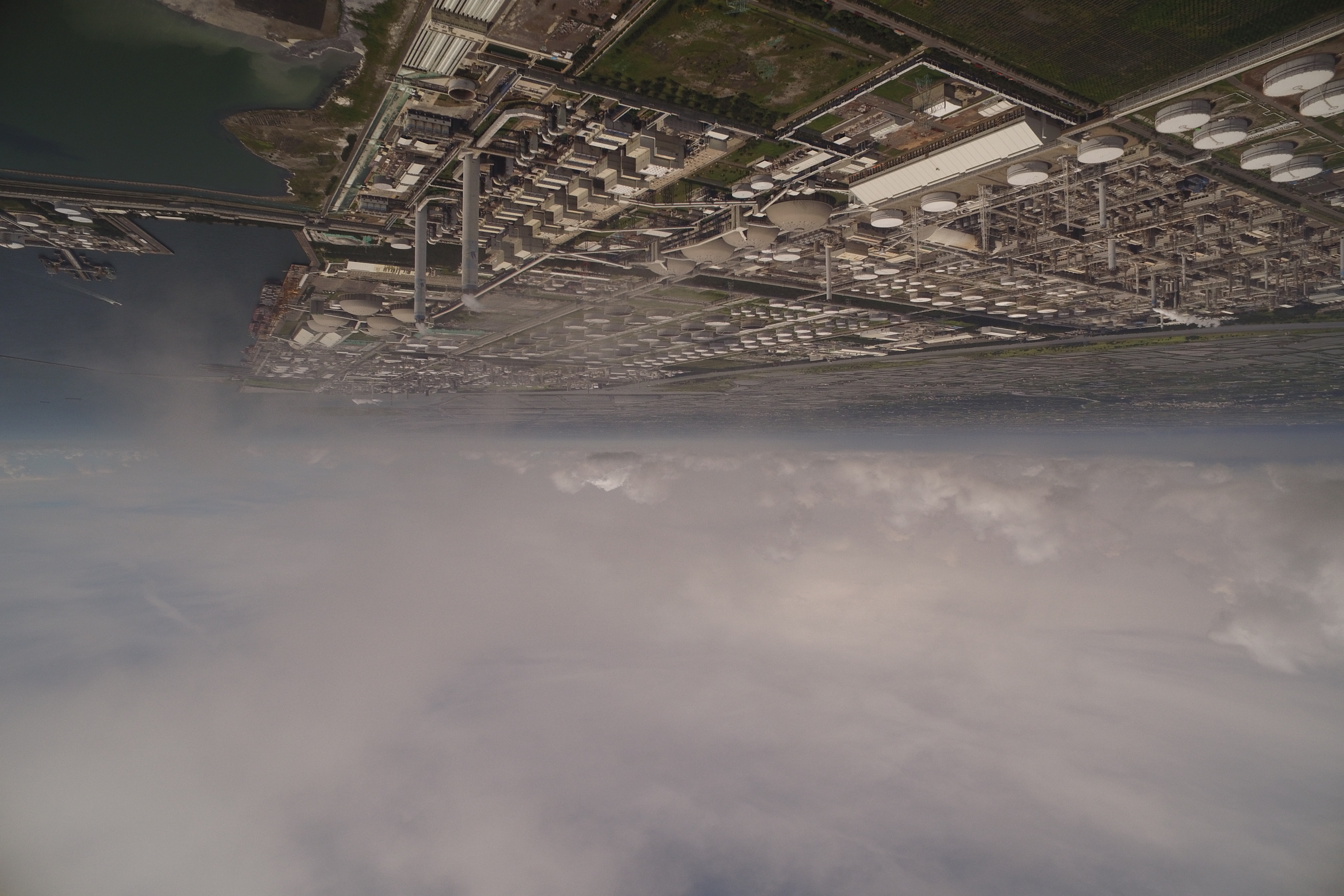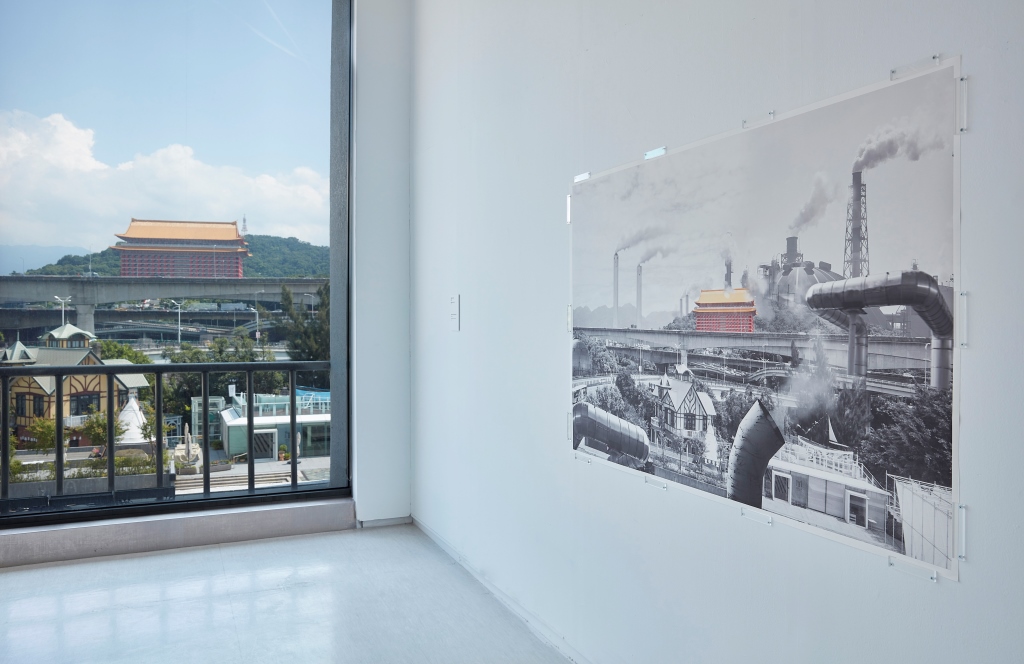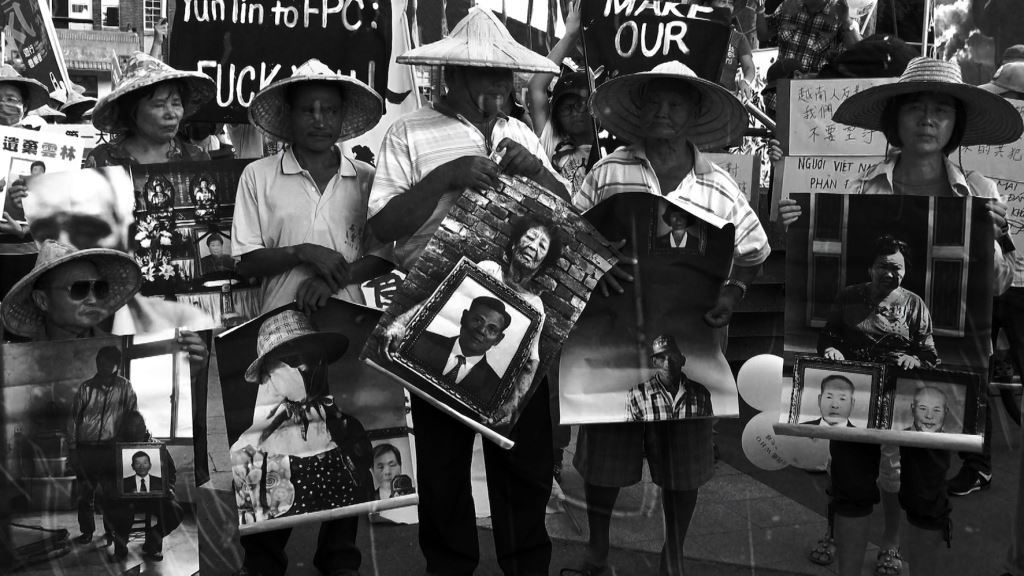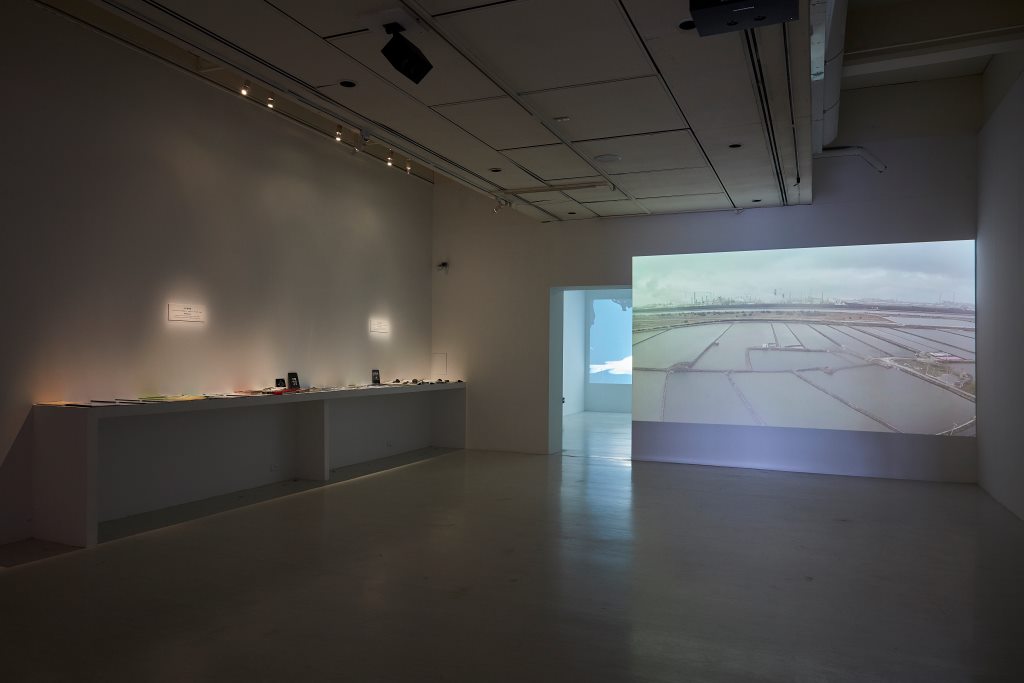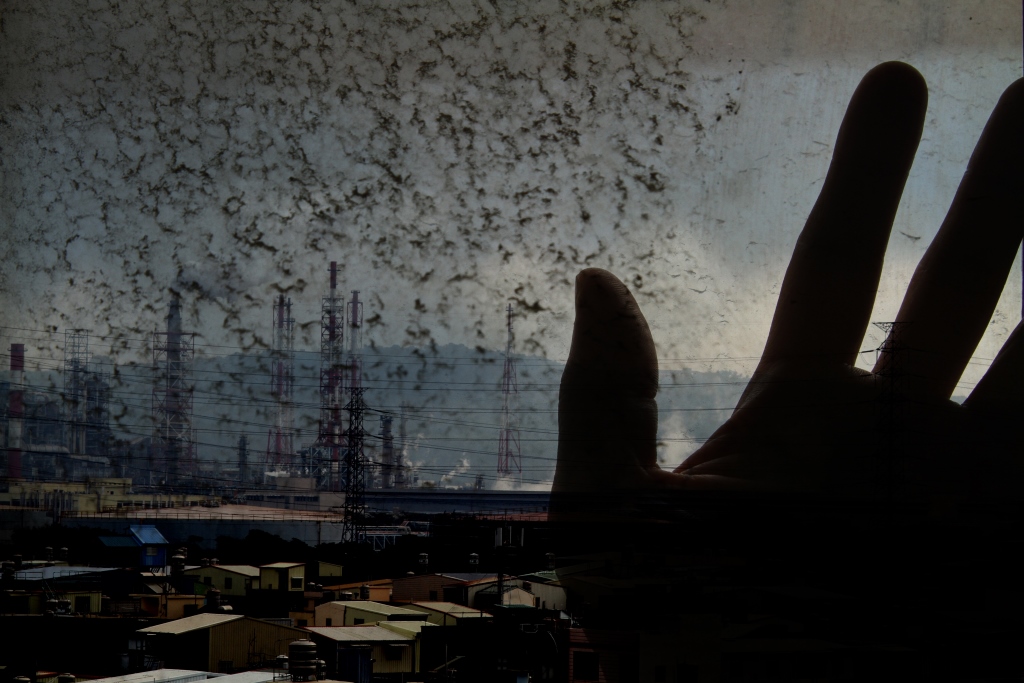《我身體就是空污監測站》源自一場公聽會,災民處於無政府保護與被犧牲狀態,就像實驗室白鼠以肉身印證環境污染,取代無力監測的空污數值。
此「反美學」之藝術展,既是環境污染展覽,也可視為環保宣傳展覽,或是環保抗爭影像展覽。林泰州借用石化工業煉油「裂解」(Cracking)製程術語延伸於創作中,暗喻石化工業將人與環境造成質變並撕裂為碎片,災民與政府、廠方對立與溝通斷裂,體現其分化、衝突與矛盾本質。藝術家在影片中實踐「裂解剪接」,呼應俄國導演艾森斯坦(Sergei Eisenstein)提出的撞擊蒙太奇(Collision Montage)將兩個不同畫面剪接在一起產生新的概念與意義,也呈現「第三電影」(社會運動電影)的影片語法,在紀錄事件中做裂解的影像處理。
My Body is an Air Quality Monitoring Station began with a public hearing where victims exist as sacrificial lambs without governmental protection, like laboratory mice using their bodies as evidence of environmental pollution in the place of the ineffective monitoring of the air pollution index.
This “anti-aesthetic” art exhibition is also an exhibition of air pollution, and may be regarded as a promotional exhibition on environmental protection, or an exhibition of images of environmental protest. LIN Tay-Jou references and extends the petrochemical industry jargon for the refining “cracking” process in his work with the implication that the petrochemical industry has qualitatively altered the environment and human beings and caused it to fissure and fragment. Confrontations and the breakdown of communications between the victims versus government and industry are physical expressions of the nature of this polarization, conflict, and contradiction. The artist’s practice of split edits in the film responds to the Collision Montage suggested by Russian director Sergei Eisenstein – constructing a new concept and significance by juxtaposing two disparate images, while also presenting the film grammar of the Third Cinema (social activism film), using a dialectical system of jumps, breaks and irrationality to “split process images within a documented event”.
林泰州 LIN Tay-Jou
英國愛丁堡 Napier大學影視製作碩士,現於國立雲林科技大學視傳系任教的林泰州近年投身環境影像記錄與創作,視記錄影像為公民監督國家機器的儀器。曾獲威尼斯影展未來電影協會首部長片獎、上海電視節亞洲紀錄片白玉蘭獎、台北美術獎優選獎。2015年投入環保運動,組成「PM2.5影像行動小組」,2016年與雲嘉南影像工作者進行《脫口罩•找藍天》影像行動計劃。
With a Masters degree in Film and Television Production from Napier University in Edinburgh, UK, LIN Tay-Jou is currently a university instructor. He has devoted himself in recent years to the documentary and production of environmental images, and regards documentary images as an instrument of the citizenry for supervising the state. He is a recipient of prestigious accolades including selection by the Venice Film Festival New Territories category, the Shanghai Television Festival Magnolia Award for Best Asian Documentary, and Taipei Art Awards Honorable Mention. He has been engaged in environmental activism since 2015, with the formation of the PM2.5 Action Group, and was involved with in the video activism project entitled Take off the Hygiene Mask • Seek Out Blue Skies with image workers in the Southwest Coast National Scenic Area.
PM2.5影像小組PM2.5 Action Group
始於2015年由林泰州與馮偉中、蔡崇隆、李孟哲組成。此次北美館林泰州《我身體就是空污監測站》個展,三位導演協助部分空拍與企劃。
The PM2.5 Action Group is a project began in 2015, driven by LIN Tay-Jou with directors Jimmy FENG, TSAI Tsung-lung and MJ LEE. The three directors assisted in aerial photography and planning for the exhibition of the My Body is an Air Quality Monitoring Station at the Taipei Fine Arts Museum.
林泰州
葉光芃、詹長權、廖榮祥、吳松霖、陳泰安、王敏玲、莊秉潔、林富源、施月英、許心欣、陳椒華、楊澤民、林春強、張 漢、吳日輝、顏淑女、黃義英、洪富賢、張淑芬、楊國禎、邱春華、咳血媽媽等六十多人。
林泰州
馮偉中
喬慰萱、蔡崇隆
千鳥藝術
台北市立美術館3A1
關鍵字
藝術家談作品
「我的影片不是愉悅之藝術,而是社會行動與抗爭。」林泰州說,原本只是單純記錄環保運動的他,看到石化工業持續「合法污染」
「我要請環保署告訴我,那個監測器在測什麼?如果台大詹長權老師可以監測到苯,我們的政府是不是只有監測到笨?」一位環保媽媽在環境公聽會中沈痛的呼籲。在空污嚴重的雲林彰化沿海,環境災民處於無政府保護與被犧牲狀態,其邊陲弱勢難以翻轉的環境現實就像處於「被壓迫的南方」經驗,燃煤發電工業供給北部享用而污染罹癌留在當地造成「區域的不正義」。
林泰州的《我身體就是空污監測站》系列創作始於這場公聽會。在大學任教的他有感當地居民的無奈,因而投身環保運動。此次展覽便是林泰州近三年參與環保運動所拍攝的作品集結,包含紀錄片、錄影藝術、MV與反空污宣導影片,實踐影像藝術作為媒體武器的意義,希望藉此喚起大眾對於空污與燃煤議題的重視。
藉「反美學」藝術展作為環境抗爭
「我的影片不是愉悅之藝術,而是社會行動與抗爭。」林泰州說,原本只是單純記錄環保運動的他,看到石化工業持續「合法污染」,環保單位始終「置身事外」,遂以影像發表的方式揭露不公,也針對「有問題」與「非正義」的現況提出質疑。
在創作之前,林泰州花了很長的時間,對石化工業進行研究和田調。他借用石化工業煉油「裂解」(Cracking,高溫分子氫化物分裂成小分子之不可逆反應)製程術語延伸於創作中,除了反映製程產生污染微粒PM2.5,也以石化製程概念作為創作去質疑石化工業。
「不僅是製程,石化工業的裂解反映在許多層面。」林泰州說,它讓人與環境造成解構質變,人與自然產生疏離異化,高經濟工業霸權落腳貧窮邊陲地帶「搶水圈地」,環評現場災民與政府廠方的對立與溝通斷裂。林泰州將「裂解」視為一種關係爆裂之隱喻,在作品中體現其分化、衝突與矛盾本質。
圓山若是工業區,台北人會關心嗎?
此次展覽分為五個區塊,入口區的主視覺與主題抗爭影片《我身體就是空污監測站》,是林泰州參與環保運動的第一號影像作品。第二區以污染的工業廢爐渣搭配影像作品《看不見的鬼島》,一旁同步呈現環保署環評公聽會的報告與學者環境研究論文。第三區是環境災民的控訴,呈現《好美麗的煙囪》、《黑色星球獎的啟示》、《那煙燻濕了你的眼》及《我身體就是空污監測站》系列照片等國內外環境災民控訴作品。第四區是投身環保運動之影音行動與抗爭,由七台電視播出八部反空污遊行的短片。最後的區域則是污染微粒與形上探討,將空污微粒延伸到宗教「塵埃」與「空性」的淨化詮釋,作為展覽探索之終點。
林泰州說,空拍《看不見的鬼島》這部片時,他強烈感受到俯視工業體就像是個環境強暴犯,機房是它的心臟,輸油管是它的大腸,油槽是它的胃,而煙囪就是侵犯環境的生殖器。而在《我身體就是空污監測站:證言照片》中,工業區災民飽受污染罹癌之肉身,以及剛手術切除的血紅之黑肺,呈現衝擊性的視覺反差,正是災民以肉身病變印證污染的無言抗議。
也許雲林離台北太遠,北部人無法感受空污之痛吧!林泰州刻意將台北市立美術館展覽現場外的圓山風景區照片,合成加入中南部工業區的煙囪、輸油管與油槽,與展場外晴空朗朗的圓山窗景形成強烈對比。他希望讓台北觀眾能感受到中南部工業污染與空氣灰濛的生存現實,不要認為「工廠離我家遠而不關我事」而抱持著疏離態度。
本展覽是國內少數將空污議題結合影像裝置的展現,既是環境污染展覽,也可視為環保抗爭影像宣傳展覽。林泰州說,若有更多人瞭解空污嚴重進而在實際生活中落實「節能減碳」並參與環保行動,那這場在美術館進行的「微行動」,也就達到階段性的成效了。
評審談作品
結各種強大影像能量,在首都美術館集中聲量控訴政府監督職責的旁落,催化了難以收拾的現代怪獸。
入圍理由
你們用機器探測,我們卻用身體罹癌率來探測空污。科技網絡提高遠方各種知識奇觀的享受,也加速邊緣的忽略,跨國資本主義知識經濟產銷網絡更讓某些邊緣區域承擔貧窮與致命污染而難以翻身。林泰州在這集體的麻痺狀態,發起了一個名為「PM2.5影像行動小組」的計劃,聚焦在雲林麥寮工業區對環境與人體造成的汙染危害,並集結各種強大影像能量,在首都美術館集中聲量控訴政府監督職責的旁落,催化了難以收拾的現代怪獸。(主筆/黃海鳴)
Comments on the finalist artworks
Some people use machines for monitoring. We, on the other hand, monitor air pollution with the cancer risk our bodies are exposed to. Technological networks have enabled us to enjoy a wide spectrum knowledge of spectacles from remote places, but it has also aggravated our negligence on the marginal community. In addition, international capitalism and the network of the knowledge economy has led to the inescapable poverty and pollution some peripheral regions have been inflicted with.


